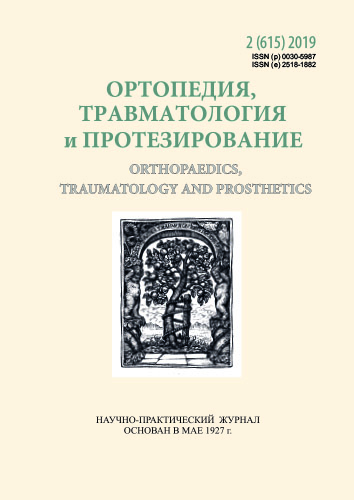Optimization of treatment tactics of combined talus and thoracolumbar spine fractures
DOI:
https://doi.org/10.15674/0030-59872019236-42Keywords:
combined injuries, talus, spine, surgical treatmentAbstract
The combined injuries of the talus and spine are related to severe injuries. There are differences in the choice of tactics for the treatment of injuries of this localization, the sequence and the necessity for surgical interventions, as well as methods of fixation. Unfavorable results of the treatment encourage the need to optimize of treatment tactics, to revise the terms and stages of surgery.
Objective: to determine the treatment tactics and optimal surgical technique in patients with combined injuries of the talus and spine.
Methods: retrospective analysis of treatment of 5 men aged from 22 to 35 years, with combined damages of talus bone and thoracolumbar spine was made. The tactics of surgical intervention was based on the early activation of patients through the applying of modern methods of osteosynthesis based on the assessment of the morphology of the injury and the prognosis of functional disorders. At the first stage, the measures included the primary anatomical surgical restoration of the talus with internal fixation, at the second stage — stabilization of spinal fractures with posterior transpedicular fixation.
Results: the consequences of combined injuries were studied in terms of 1 to 3 years follow-up. Surgical treatment of talus injuries with differential timely approach allowed us to achieve improvement of anatomical and functional results — (90.5 ± 3.2) points according to AOFAS scale, FFI — (4.8 ± 0.4) points (p ˂ 0.05). The loss of correction of kyphotic deformation was 7.9 ± 0.2°. Oswestry index of pain syndrome did not exceed 20 %, which corresponded to a minimum violation and a good follow-up result that allowed patients to return to their previous physical activity.
Conclusions: the tactics of surgical treatment of combined injuries of the talus and thoracolumbar spine requires a differentiated approach in the order and timing of surgical interventions, significantly affects the improvement of functional results in most patients.
References
- Korzh, N. A., Gerasimenko, S. I., Klimovickij, V. G., Loskutov, A. E., Romanenko, K. K., Gerasimenko, A. S., & Kolomiec, E. N. (2010). Distribution of bone fractures and results of their treatment in Ukraine (clinical-epidemiological investigation). Orthopaedics, Traumatology and Prosthetics, 3 (580), 5–14. doi: 10.15674/0030-5987201035-14. (in Russian)
- Radchenko, V. O., Popsujshapka, K. O., & Teslenko, S. O. (2017). Modern outlook of treatment methods of fire-arms fractures of thoracolumbar part of spinal column (review of literature). Part 1. Trauma, 6 (18), 152–161. doi: 10.22141/1608-1706.6.18.2017.121194. (in Ukrainian).
- Bondarev, V. B., Kalenskij, V. O., & Ivanov, P. A. (2016). Features of rearfoot injuries in patients with multisystem trauma. Zhurnal im. N. V. Sklifosovskogo Neotlozhnaja medicinskaja pomoshh', 2, 20–24. (in Russian).
- Korolev, M. A., Yarmak, D. O., Miroschnikova, C. A., Moldakulov, J. M., Skoroglyadov, A. V., & Korobushkin, G. V. (2016). Diagnostic errors and management of foot fractures in patients with multiple or concomitant injuries. Vestnik RGMU, 3, 48–55. doi: 10.24075/brsmu.2016-03-07. (in Russian).
- Ahrberg, A. B., Leimcke, B., Tiemann, A. H., Josten, C., & Fakler, J. K. (2014). Missed foot fractures in polytrauma patients: a retrospective cohort study. Patient Safety in Surgery, 8 (1), 10. doi: 10.1186/1754-9493-8-10
- Ardashev, I. P., Ardasheva, E. I., Afonin, E. A., & Voronkin, R. G. (2009). The treatment of concomitant spine and hindfoot injuries. Hirurgija pozvonochnika, 3, 14–19. (in Russian).
- Skorogljadov, A. V., Korobushkin, G. V. & Naumenko, M. V. (2012). The analysis of outcomes of treatment of talus injuries. Rossijskij medicinskij zhurnal, 5, 22–24. (in Russian).
- Popsuishapka, K. O. (2016). Metaanalysis of treatment results in lower thoracic and lumbar spine burst fractures. Orthopaedics, Traumatology and Prosthetics, 4, 134–142. doi: 10.15674/0030-598720164134-142. (in Ukrainian).
- Gaiko, G. V., Nіkіtіn, P. V. & Kalashnikov, A. V. (2002). Reasons of disability in patients with injuries of foot bones. Vіsnik ortopedіі, travmatologіі ta protezuvannja, 4, 79–83. (in Ukrainian).
- Aebi, M., Arlet, V., & Webb, J. K. (2007). AOSpine Manual. Stuttgart, Germany: Thieme.
- Aebi, M., Arlet, V., & Webb, J. K. (2007). AOSpine Manual. Stuttgart, Germany: Thieme.
- Radchenko, V. A., & Korzh, N. A. (2013). Spinal pathology: Text-book for doctors. Kiev: Zdorov'ja Ukrainu. (in Russian)
Downloads
How to Cite
Issue
Section
License
Copyright (c) 2019 Alexander Bodnya, Uriy Sukhin

This work is licensed under a Creative Commons Attribution 4.0 International License.
The authors retain the right of authorship of their manuscript and pass the journal the right of the first publication of this article, which automatically become available from the date of publication under the terms of Creative Commons Attribution License, which allows others to freely distribute the published manuscript with mandatory linking to authors of the original research and the first publication of this one in this journal.
Authors have the right to enter into a separate supplemental agreement on the additional non-exclusive distribution of manuscript in the form in which it was published by the journal (i.e. to put work in electronic storage of an institution or publish as a part of the book) while maintaining the reference to the first publication of the manuscript in this journal.
The editorial policy of the journal allows authors and encourages manuscript accommodation online (i.e. in storage of an institution or on the personal websites) as before submission of the manuscript to the editorial office, and during its editorial processing because it contributes to productive scientific discussion and positively affects the efficiency and dynamics of the published manuscript citation (see The Effect of Open Access).














